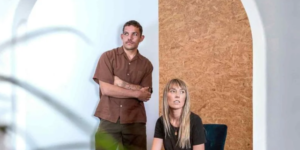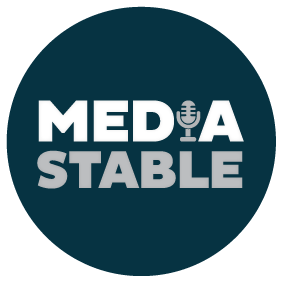Clare Reid – Marketing Mag
CEO at Lush the Content Agency
Wongutha man and Nani Creative co-owner Kevin Wilson believes creatives must use their voices to push for “what is right”. He spoke alongside Lush CEO Clare Reid at Emergence Creative, where the pair spearheaded a conversation on ‘Walking between Two Worlds’.
The duo’s work together as an Aboriginal and non-Aboriginal creative team brings First Nations’ stories and creativity into the realm of commercial communications and branding. Marketing Mag spoke with Wilson and Reid on the importance of integrating Indigenous culture into marketing.
Nani Creative describes itself as “an Aboriginal-led creative agency powered by what’s to come”. It was formed when Wilson first entered the industry and said he felt “super uncomfortable about expressing [himself] culturally”.
His first experience within the realm of design was working under a wadjella (white) senior designer. He shares how he felt the pressure of balancing the job that pays his rent, while also working in a way in which he had agency over his work.
Situated in Western Australia, Wilson says the gap between commercial creativity and Aboriginal culture can feel like “uncharted waters”. He notes there are only a “few blackfullas [sic] in the creative design agency”. “While we are taking up space, the balance is far from what I feel is needed,” Wilson adds.
“Our mob are creators, storytellers and artists – yet on the tail end of projects, these stories are being signed off by white hands. There’s so much potential to bring mob to the table and foster involvement from start to finish within any project.”
Wilson believes that “genuine storytelling” from First Nations people can benefit society. “With so much to learn about the land, our place in [the] community, our obligations to family and the world around us, we would all be better if we sat down, listened and made space for First Nations mob,” he says.
The genesis of the partnership
The collaboration between Lush and Nani Creative teaches us how marketing initiatives can be respectful and authentic when representing Indigenous culture.
Reid says: “As non-Aboriginal creators and thinkers, we’re there to listen and prioritise the perspectives of the people who hold the cultural knowledge. When we’re invited into this space, we’re motivated by adding value to projects and propelling the work forward.”
With big voices, brands have a responsibility to promote cultural diversity and inclusion in their marketing and to use them for good. With the media buying power to bring these stories to the masses, tokenised representation is just not good enough.
“We need nuanced stories, not diversity box tickers,” Reid says. “The way we craft these narratives, led by those with lived experience, has the power to elicit empathy, connection and belonging which plays an essential role in challenging stigma.”
You can’t be what you can see
Wilson explains that a good friend once told him ‘You need to see it to be it’ – which is now something by which he lives by. “Seeing people like us in campaigns, on TikTok, radio, behind the camera, or even seeing art in our everyday life empowers us,” he says. “It reminds us that we’re still here – that we’re being seen.”
There are so many highly talented agencies and freelance creators who come to the table with lived experience so it’s vital that marketers work directly with those whose perspectives they want to incorporate. Reid says “lived experience is incomparable”.
“The work that we produce in this industry is firstly made to be seen, then – if we get it right – it has the power to spark conversations and influence change,” she says.
“Kevin and the team at Nani are the champions of this process. As one of their partner agencies on First Nations works, we are led by their deep cultural knowledge and the consultation processes in place for each project.”.
Ensuring cultural safety and respect
Many brands may see integrating cultural diversity and perspectives into marketing as a challenge, but in truth, the challenge actually stems from a systemic emphasis on ‘cultural load’.
Wilson describes cultural load as the “invisible obligations placed on First Nations employees – when they are expected to check work, give advice and provide sign off – all usually outside of their job description, just because they happen to be First Nations and are ‘within arm’s reach’.”
Reid transparently explains that like many other non-Aboriginal people, she was largely unaware of cultural load. “I was constantly asking for approval on every little piece of work which absolutely contributes to the problem,” Reid says. “Really, I was looking for a way to alleviate my fear of doing something wrong when in fact I needed to provide solutions.”
In ensuring cultural safety and respect in marketing collaborations, Wilson says “assessing your cultural capability level” is a good place to start. It’s as simple as a Google search to figure out where you sit as an individual. There isn’t a step-by-step guide that Wilson can share. He’s been asked many times to provide the answers, when in reality it’s actually a journey that individuals or organisations must personally embark on.
Weaving stories into campaigns
Most of the work Nani completes involves threading First Nations culture into projects – whether that be through collaborations with artists to visually bring culture into brands, or with knowledge holders who weave stories into campaigns.
Lush and Nani Creative have been working alongside each other over the past year on the Aboriginal Cultural Centre project in WA.
Wilson’s expertise has also made him a leader in the branding and design projects for Wadjemup/Rottnest Island, Transperth, WA Museum, Beyond Blue, Aboriginal History WA, and Tourism WA.
“The biggest misconceptions that marketers have about working with Indigenous communities is assuming the capability of our mob,” Wilson says. The World Down Syndrome Day 2024’s recent ‘Assume That I Can’ campaign resonates with Wilson for these same specific reasons.
“Our people need more opportunities to be invited into the initial conversations and given the space to guide the project in a way that will be more impactful,” he says.
Creating a more inclusive and equitable marketing space
On their thoughts for the future, Reid says self education and awareness are essential. “There are plenty of resources online about creating cultural safety in the workplace which is a great starting point,” Reid says.
Wilson hopes to see more Indigenous creatives in the industry across all areas. “I’m not sold that the entire industry is ready, and there are a lot of existing barriers that make it not as appealing as others,” he says.
Nani Creative offers an internship program that contributes to the solution and invites prospective creatives into the industry with Wilson speaking regularly at public forums and panels on this topic.
It’s an issue that we all need to work on, not just First Nations people.
Photography supplied by Nani Creative and Lush – The Content Agency.
